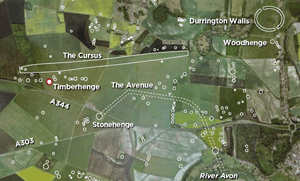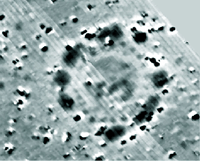
A discovery near Stonehenge shows the promise and pitfalls of dig-less archaeology

New discoveries are showing that Stonehenge was just one part of a ritual landscape littered with dozens of monuments and burial mounds indicated here by white circles. |

The magnetometer image of the newly discovered Timberhenge shows a circle of what would have been large postholes. Scientists disagree about how to interpret the image. Some think the darker gray circle in the center may be the remains of a burial mound. (Courtesy University of Birmingham)
Half a mile from Stonehenge, amid a cluster of burial mounds known as barrows, a team of archaeologists led by the University of Birmingham's Vince Gaffney made what could be a huge discovery. Gaffney was using remote-sensing devices to create a map of underground cavities and contours that may reveal traces of how ancient people used the landscape around Stonehenge. The instruments sent back images that revealed a circular arrangement of black spots surrounded by a ring of small ditches. Gaffney interpreted the pattern of spots in the image as the remains of a henge, or ceremonial circle, that was probably made of timber instead of stone. The whole structure would have sat on a slope overlooking the famous stone monument.
The discovery garnered international attention. News reports called it "Stonehenge's timber twin" and Gaffney and others called it the most important archaeological find at Stonehenge in over 50 years. But is it a henge? There is no visible trace of it now, and a number of archaeologists believe it could be the remains of a barrow, of which there are hundreds within a few miles of Stonehenge.
Roger Atwood is a contributing editor at ARCHAEOLOGY.
Advertisement

Advertisement







